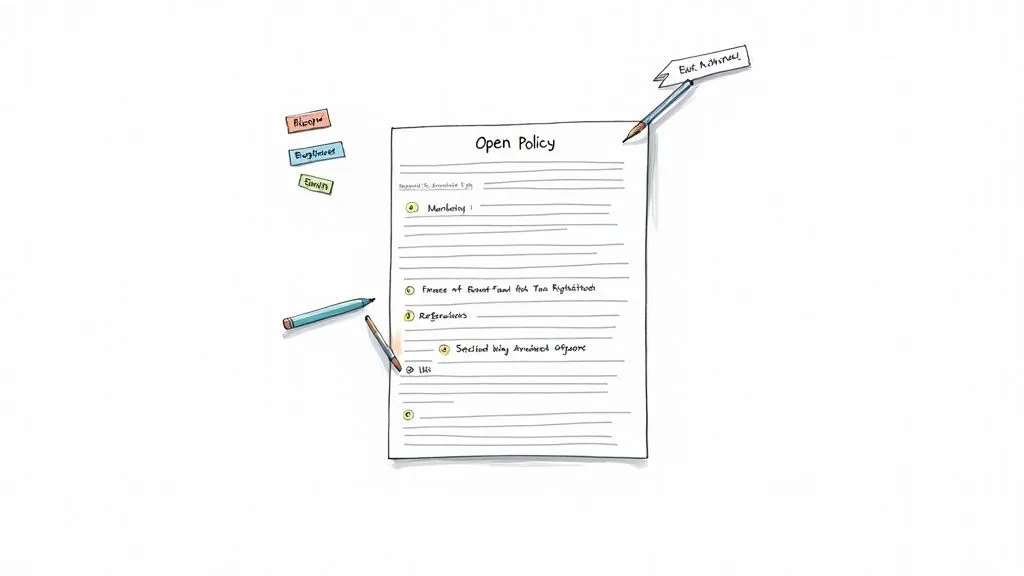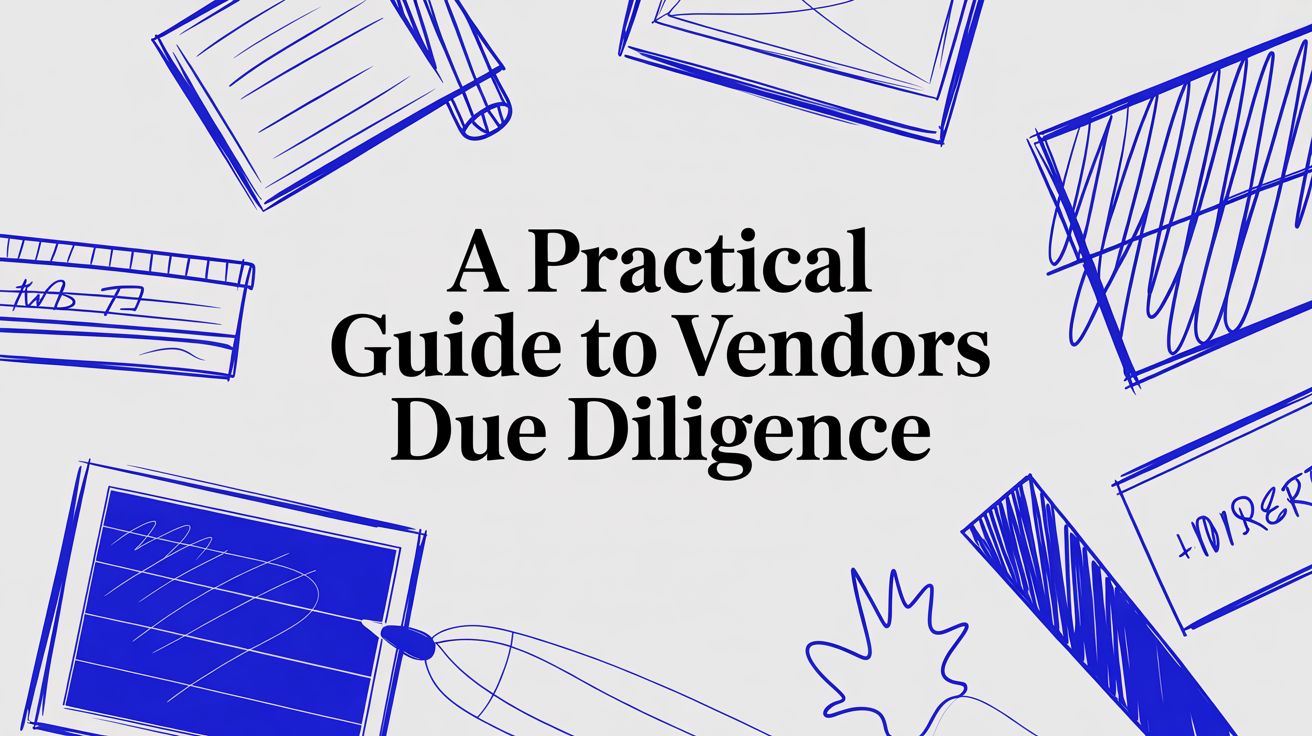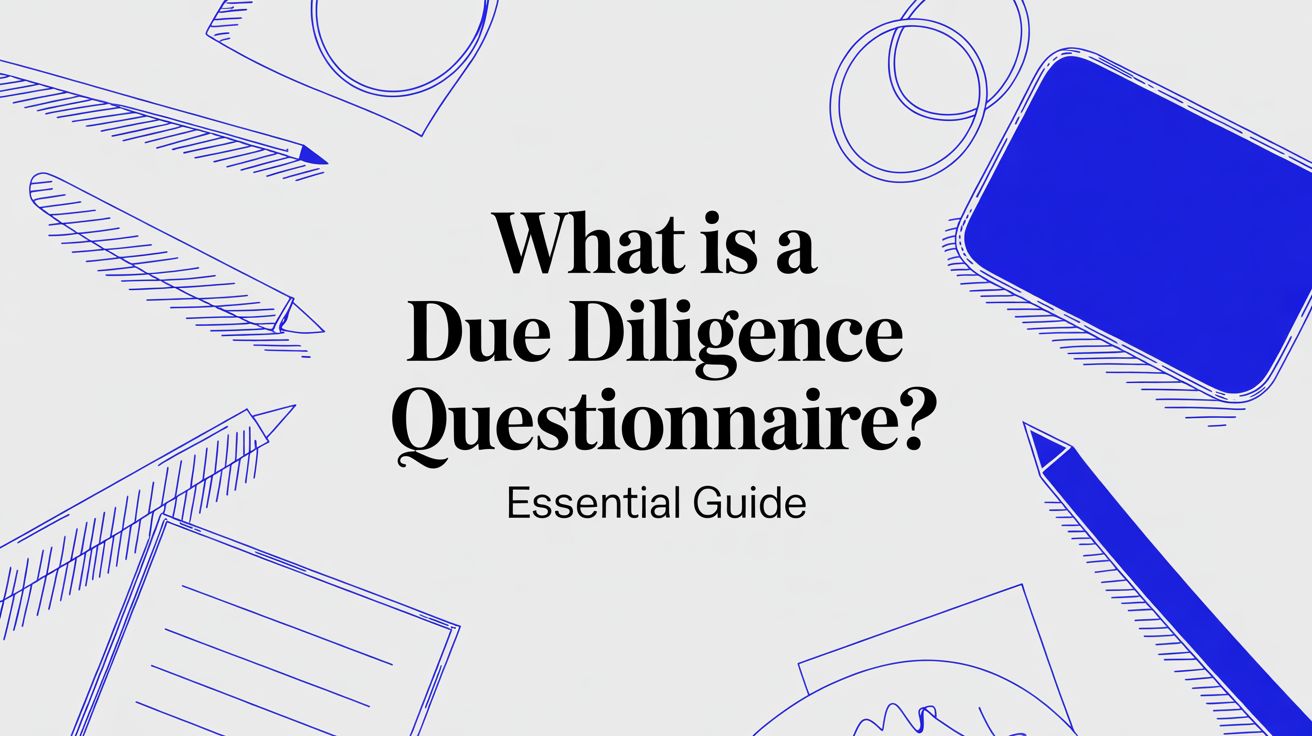· Jane Iamias · data protection policy template uk · 17 min read
data protection policy template uk: Free UK Compliance Guide
Implement data protection policy template uk with a ready-to-use template, policy examples, and clear steps to achieve compliance. Download now.

Trying to make a generic, off-the-shelf policy fit UK data protection laws is like trying to fit a square peg in a round hole. It just doesn’t work. What you actually need is a data protection policy template specifically for the UK, one that’s built from the ground up to align with the UK GDPR and the Data Protection Act 2018.
This guide gives you exactly that, but more importantly, it walks you through how to tailor it so it genuinely reflects how your business operates.
Why a Proper UK Data Protection Policy Isn’t Optional

It’s easy to think of a data protection policy as just another bit of legal paperwork to tick off a list. That’s a huge mistake. In practice, this document is the internal rulebook for your entire organisation. It governs everything from how your sales team manages CRM data to how HR handles employee records.
Without this foundational policy, you’re not just risking a fine; you’re essentially flying blind in a very complex and unforgiving regulatory landscape. The UK’s framework demands accountability and transparency, and a vague policy downloaded from a US website simply won’t cut it. It will miss the specific nuances of British law, leaving you exposed.
The Real Cost of Getting It Wrong
Let’s be clear: the Information Commissioner’s Office (ICO), the UK’s data protection watchdog, has teeth. The penalties for non-compliance are severe, reaching up to £17.5 million or 4% of your annual global turnover—whichever figure is higher. It’s not just the big players who get hit, either. A small recruitment firm could easily face a five-figure fine just for holding onto CVs for too long without a clear retention schedule laid out in their policy.
But the financial hit is only part of the story. A data breach or a publicised compliance failure can shatter customer trust overnight. People are more savvy than ever about their data rights. A solid, well-thought-out policy isn’t just about avoiding fines; it’s a signal to your customers that you respect their privacy. It’s a trust-builder.
For a great real-world example of how to communicate these commitments clearly, take a look at this example privacy policy which does a good job of laying everything out for the public.
Keeping Pace with a Moving Target
UK data protection law is anything but static. It’s constantly being updated to keep pace with new technologies and changing expectations. A recent example is the introduction of new regulations that amend the UK GDPR and DPA 2018, refining requirements for things like scientific research and clarifying the use of data for crime prevention. You can read up on the latest official changes on the government’s website.
This constant evolution means your policy can’t be a “set it and forget it” document.
A data protection policy is more than a document; it’s a living instrument of your company’s commitment to ethical data handling. It should evolve with your business and the law, acting as a dynamic guide for your team.
It needs to be reviewed regularly and updated whenever your processes change or the law shifts. Think of it less as a static file and more as a dynamic tool that builds resilience and protects your business.
Getting to Grips With Your Policy: A Clause-by-Clause Guide

Starting with a blank page is intimidating, which is why a good template gives you the skeleton. Now it’s your job to add the flesh and blood—the specific details that make the policy truly yours. This is the exact point where a generic download falls flat and a tailored data protection policy template for the UK proves its worth.
Every single clause in our template is designed to map directly to a requirement under the UK GDPR or the Data Protection Act 2018. Let’s walk through how to adapt the most critical sections, moving from theory to practice with some real-world examples.
Who’s Doing What? Defining Roles and Responsibilities
First things first, you need to assign accountability. This isn’t just about ticking a box by naming a Data Protection Officer (DPO), assuming you even need one. It’s about creating a clear chain of command for data protection duties right across your business.
Your template will have a placeholder for the main data protection lead. For some, this will be a formally appointed DPO. For smaller businesses, it’s often a senior manager wearing another hat. Whatever your structure, get specific.
- Marketing Manager: Owns the responsibility for ensuring all marketing campaigns have a clear, documented lawful basis (like consent for newsletters) and that unsubscribe requests are actioned immediately.
- Head of HR: Is accountable for the secure handling and retention of all employee data, from contracts and performance reviews to sensitive health information.
- IT Manager: Is tasked with implementing and maintaining the technical nuts and bolts—encryption, access controls, secure data wiping procedures, and so on.
Adding this level of detail transforms your policy from a document that gathers dust into a practical, everyday guide for your team.
Documenting Your Lawful Bases for Processing
Under UK GDPR, you can’t just process data because you feel like it. You need a valid lawful basis for every single thing you do with personal information, and your policy needs to document it. This is one of the most common pitfalls I see—businesses defaulting to ‘consent’ for everything, when another basis is often far more appropriate.
Let’s look at a couple of typical departments:
An HR Department Example:
- What are they doing? Paying employees.
- What data is involved? Bank details, salary, National Insurance number.
- What’s the lawful basis? Contractual Necessity. It’s simple: you need this data to fulfil your side of the employment contract.
A Marketing Department Example:
- What are they doing? Sending a monthly email newsletter to existing customers about new product features.
- What data is involved? Name, email address, maybe some purchase history.
- What’s the lawful basis? Legitimate Interest. You have a genuine business interest in keeping customers in the loop, as long as it doesn’t trample on their rights. Crucially, you must always provide a clear and easy way to opt out.
Clearly stating these distinctions in your policy is a massive step towards demonstrating compliance if the ICO ever comes knocking.
Setting Data Retention Schedules That Actually Work
You can’t keep personal data forever “just in case.” The principle of storage limitation is crystal clear: you must only hold onto data for as long as is strictly necessary. That means your policy needs a proper retention schedule.
Vague statements like “we will keep data for as long as needed” simply won’t cut it. You need to be precise.
- Unsuccessful Job Applicant Data: Keep for 6 months after the recruitment process ends to handle any potential challenges, then securely delete it.
- Customer Purchase Records: Retain for 6 years plus the current financial year. This aligns with HMRC’s requirements for tax purposes.
- Client Project Files: Hold for the duration of the project plus 2 years afterwards to deal with any follow-up questions or issues.
These kinds of specific timeframes give your team clear instructions and show regulators you’ve put real thought into your processes. For more ideas on structuring these kinds of rules, it can be useful to see how other companies handle their documentation. We’ve collected some great information security policy examples that might spark some inspiration.
Outlining Your Breach Notification Process
When a data breach hits, panic is your worst enemy. A clear, pre-defined process laid out in your policy is your best line of defence, ensuring a calm, measured, and compliant response. This clause is non-negotiable and must spell out the mandatory 72-hour reporting rule to the ICO.
Example Clause Language: Data Breach Notification “Upon discovery of a suspected personal data breach, the employee who found it must immediately report the incident to the Data Protection Lead. The Lead will then conduct a rapid assessment to understand the nature of the breach and the potential risk to individuals. If the breach is likely to result in a high risk to the rights and freedoms of individuals, we will notify the Information Commissioner’s Office (ICO) without undue delay, and where feasible, no later than 72 hours after becoming aware of it. We will also notify any affected data subjects directly and without undue delay.”
This section should also detail your internal logging procedures. Remember, you have to record all breaches, even the minor ones you don’t end up reporting to the ICO.
Bringing Your Policy to Life: Implementation and Team Training
A brilliant data protection policy isn’t worth much if it’s just gathering digital dust on a server somewhere. To turn it from a document into a genuine business asset, you need to weave it into the fabric of your company culture. This goes way beyond sending out a quick email announcement; it requires a proper plan for rolling it out and getting everyone on board.
The real goal here is to shift your policy from a list of rules into a shared sense of responsibility. Your team needs to grasp not just what the policy says, but why it’s crucial for their day-to-day work. After all, a policy that nobody reads is a compliance incident waiting to happen.
A Practical Implementation Checklist
Getting your policy up and running needs a bit of structure. Think about how you’ll communicate it, where it will live, and how it becomes part of everyone’s routine. This isn’t a one-and-done job; it’s the start of an ongoing commitment.
Here’s a simple checklist to get you started:
- Spread the Word: Announce the new policy using a few different channels—an all-hands meeting, a clear email, and a post on your intranet. Explain what’s different and why it matters for the business and your customers.
- Easy Access is Key: Don’t make people dig through a maze of folders to find it. Pin it to a central, obvious place like a company wiki or knowledge base.
- Build it into Onboarding: Make reading and acknowledging the data protection policy a standard part of the induction process for all new starters. It sets the right tone from their very first day.
Your policy’s success isn’t measured by how well it’s written, but by how well it’s understood and followed. Treat implementation and training with the same seriousness you gave to drafting the document itself.
Designing Training That Actually Works
Training is where your policy document truly comes alive. Forget those mind-numbing, text-heavy slideshows that just put people to sleep. Good training is relevant, engaging, and tailored to specific roles. The idea is to build muscle memory around smart data handling.
For instance, your sales team needs to know the specific rules for adding prospects to your CRM. Your IT team, on the other hand, needs to be experts in the technical steps for secure data disposal. A solid policy should even include practical employee guidance, such as detailing how to totally wipe an iPhone before selling it.
Always keep a log of who attended which training sessions and when. This simple record becomes priceless evidence of your commitment to compliance if you ever face an audit or an ICO inquiry.
Setting a Regular Policy Review Cadence
Data protection isn’t a “set it and forget it” task. Your business changes, technology moves on, and the law gets updated. For instance, the transition period for the Data (Use and Access) Act 2025, which runs from 19 June 2025 to June 2026, gives UK organisations 12 months to get their policies in order. This Act brings new rules for things like automated decision-making and cookie consent, meaning both your internal and external policies will need a refresh.
It’s vital to have a formal review schedule in place to keep your policy fit for purpose. A full review at least once a year is a sensible baseline.
You should also plan for an immediate review if certain events happen:
- There’s a significant change in UK data protection law.
- Your company rolls out new technology that handles personal data in a new way.
- You launch a new product or service that involves collecting different types of data.
- The business goes through a major change, like a merger or acquisition.
This proactive approach ensures your data protection policy template for the UK remains a living, effective tool that genuinely protects your business.
Handling DPIAs and Data Breach Reporting
 Let’s tackle two areas that often feel quite intimidating: Data Protection Impact Assessments (DPIAs) and handling data breaches. Your policy is the perfect place to demystify these by turning vague legal duties into a clear, repeatable process. Essentially, you’re creating pre-planned emergency procedures before you ever need them.
Let’s tackle two areas that often feel quite intimidating: Data Protection Impact Assessments (DPIAs) and handling data breaches. Your policy is the perfect place to demystify these by turning vague legal duties into a clear, repeatable process. Essentially, you’re creating pre-planned emergency procedures before you ever need them.
A DPIA isn’t as scary as it sounds. It’s simply a risk assessment you perform before kicking off a new project that involves processing personal data in a way that’s likely to be high-risk for individuals. It’s your way of proving you’ve carefully considered and minimised any potential data protection issues from the outset.
When to Trigger a DPIA
Your policy needs to spell out exactly what prompts a DPIA. The UK GDPR is quite specific here, making it mandatory when you’re about to introduce new technologies or process certain types of data on a large scale.
Here are a few common triggers you should definitely include in your policy:
- Introducing new technology: A great example is implementing a new AI-driven customer service chatbot that analyses and learns from conversations.
- Large-scale processing of sensitive data: Think of a health and wellness app collecting detailed fitness and medical information from thousands of users.
- Systematic monitoring of a public area: This could be installing a comprehensive CCTV system across your business premises.
Your data protection policy template for the UK should dedicate a section to this, clarifying who is responsible for kicking off the DPIA process and who needs to sign it off.
Mapping Your Data Breach Response
When a data breach hits, the initial reaction is often panic. A well-defined breach response process in your policy is the antidote, ensuring you react in a controlled and compliant manner. Trust me, this is one of the first things regulators will want to see.
The process must cover that critical window from the moment a breach is discovered to when notifications are sent. Your team needs to know this procedure inside and out, so the second a breach is even suspected, it gets escalated immediately. The clock starts ticking the moment you become aware of it.
Your policy must clearly state the legal obligation to report certain breaches to the Information Commissioner’s Office (ICO) within 72 hours. Not every little incident needs reporting, only those likely to pose a real risk to people’s rights and freedoms. For a closer look at building out this crucial process, our guide on creating an incident response plan is a really helpful resource.
Let’s walk through a scenario: an employee accidentally leaves their company laptop on a train. That laptop holds a spreadsheet with customer names, addresses, and purchase histories. While the drive is encrypted, the password was jotted down on a sticky note inside the same laptop bag. This is a clear breach. Your policy should instantly guide the team to assess the risk, attempt a remote data wipe, and start preparing the ICO notification because the data is now accessible and poses a genuine risk to those customers.
Turning Your Policy into an Automated Compliance Asset

So you’ve finished your data protection policy. What now? Far too many businesses simply file it away, treating it as a tick-box exercise. But that’s a huge missed opportunity. Your policy shouldn’t be the end of the compliance journey; it should be the start.
Think of it as the single source of truth for your entire data protection framework. When auditors come knocking or a high-value client sends over a security questionnaire, every answer you give should be directly traceable back to this document. This creates an auditable trail, proving you don’t just have rules on paper—you actually live by them.
From Static Document to Active Knowledge Base
This is where you can leave the slog of manual compliance behind. By uploading your completed data protection policy template UK into a modern knowledge base, you turn it from a dusty document into a living, working asset. Tools like ResponseHub can ingest your policy and use that knowledge to automatically answer security questionnaires.
The advantages here are massive:
- Speed: You can slash the hours your team spends hunting down answers for repetitive questionnaires.
- Consistency: Every response is perfectly aligned with your official policy, which means no more conflicting answers from different people or the risk of human error.
Your policy stops being just a document and becomes the engine driving your compliance communications. It guarantees that everyone—clients, partners, regulators—gets the same accurate, verifiable information about how you handle data, every single time.
With the ICO getting stricter, this kind of provable transparency is no longer a nice-to-have. Before recent reforms, it was estimated that around 30% of European businesses were still not fully GDPR compliant, often due to weak documentation.
You can build a solid foundation with tools like our free policy generator. By taking this next step, you transform a one-off task into a powerful system that works around the clock to keep your business safe and compliant.
Answering Your Top UK Data Protection Policy Questions
Once your data protection policy is drafted, a few practical questions almost always pop up. I’ve seen these come up time and time again with businesses just getting started. Let’s tackle them head-on so you can move forward with confidence.
Is This a Privacy Policy or a Data Protection Policy?
It’s a common point of confusion, but the distinction is crucial. They serve two entirely different audiences and purposes.
A privacy policy (often called a privacy notice) is your public-facing document. It’s what you show the world—your customers, website visitors, and service users. It transparently explains what personal data you collect, why you collect it, and what you do with it. Think of it as your public promise on data handling.
Your data protection policy, on the other hand, is the internal playbook for your team. It’s the rulebook that guides your staff on how to handle personal data correctly every single day. This document details the specific procedures, internal responsibilities, and security measures that ensure you actually live up to the promises made in your public privacy policy.
Here’s a simple analogy I like to use: Your privacy policy is the menu you give to guests in a restaurant. Your data protection policy is the detailed recipe book and kitchen hygiene manual that the chefs use behind the scenes.
Do We Actually Need a Data Protection Officer?
This is a big one, and the short answer is: maybe. It’s not a requirement for every business. The UK GDPR is quite specific about who needs to formally appoint a Data Protection Officer (DPO).
You are legally required to appoint a DPO if your organisation is:
- A public authority or body (like a government department or local council).
- Engaged in core activities that involve large-scale, regular, and systematic monitoring of people (a classic example is a private security firm using extensive CCTV).
- Processing special categories of data (like health records) or data relating to criminal convictions on a large scale.
If you don’t fit into one of those buckets, you’re not legally obliged to have a DPO. However, from experience, it’s still best practice to designate someone internally to be the go-to person for data protection. This individual can champion the policy, answer staff questions, and take ownership of keeping everything up to date. It creates clear accountability, which is always a good thing.
How Often Should We Review Our Policy?
A data protection policy should never be a “set it and forget it” document. The digital world and the laws governing it are constantly evolving.
As a general rule of thumb, schedule a full, formal review at least once a year.
That said, certain events should trigger an immediate review, outside of your annual schedule. Be ready to update your policy if:
- There are significant updates to UK data protection legislation.
- Your business adopts new systems or technologies that handle personal data.
- You launch new products or services that change how you collect or process data.
Keeping your policy current is non-negotiable. It ensures the document remains a practical, relevant, and effective tool for safeguarding your business and respecting your customers’ privacy.



